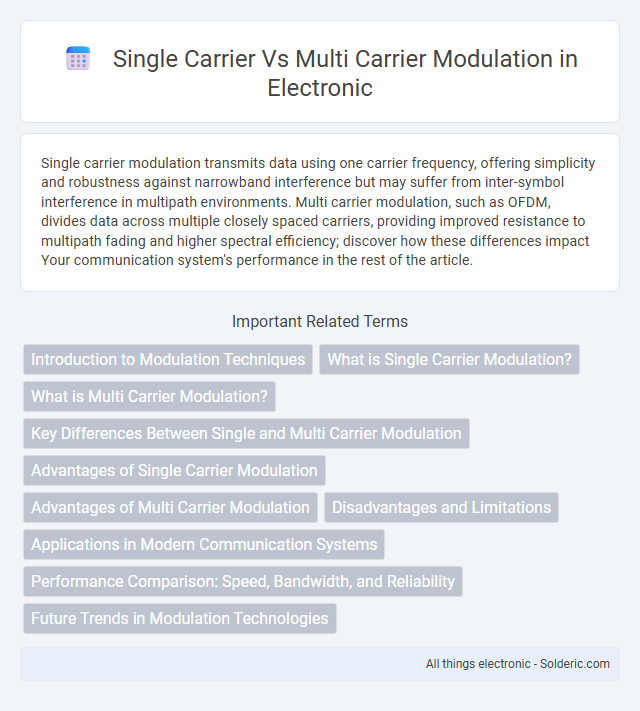Single carrier modulation transmits data using one carrier frequency, offering simplicity and robustness against narrowband interference but may suffer from inter-symbol interference in multipath environments. Multi carrier modulation, such as OFDM, divides data across multiple closely spaced carriers, providing improved resistance to multipath fading and higher spectral efficiency; discover how these differences impact Your communication system's performance in the rest of the article.
Comparison Table
| Feature | Single Carrier Modulation | Multi Carrier Modulation |
|---|---|---|
| Definition | Modulates data onto a single frequency carrier wave. | Data is split across multiple orthogonal subcarriers. |
| Complexity | Lower transmitter and receiver complexity. | Higher complexity due to FFT/IFFT processing. |
| Frequency Selectivity | Less resistant to frequency selective fading. | Better handling of multipath fading via subcarriers. |
| Bandwidth Utilization | Narrower bandwidth per symbol. | Efficient use of available bandwidth via subcarriers. |
| Inter-Symbol Interference (ISI) | More prone to ISI, requires equalization. | Minimized ISI using cyclic prefix. |
| Peak-to-Average Power Ratio (PAPR) | Lower PAPR, better power efficiency. | Higher PAPR, requires linear amplifiers. |
| Applications | Traditional radio systems, low-rate data links. | Broadband systems like LTE, Wi-Fi, DVB-T. |
Introduction to Modulation Techniques
Single carrier modulation transmits data using one frequency channel, offering simplicity and resilience in low-mobility environments. Multi-carrier modulation divides the data across multiple subcarriers, improving spectral efficiency and robustness against frequency-selective fading. Your choice depends on the application's bandwidth requirements and channel conditions, with single carrier favoring lower complexity and multi-carrier enabling higher data rates.
What is Single Carrier Modulation?
Single Carrier Modulation (SCM) transmits data using one carrier frequency, offering simplicity and reduced peak-to-average power ratio compared to multicarrier systems. SCM is commonly used in traditional communication systems like GSM and CDMA due to its robustness against nonlinear distortion. This modulation technique encodes information by varying amplitude, frequency, or phase of the single carrier wave, enabling efficient use of bandwidth in narrowband channels.
What is Multi Carrier Modulation?
Multi Carrier Modulation (MCM) is a technique that divides a high-rate data stream into several lower-rate streams, which are transmitted simultaneously over multiple carrier frequencies. This method enhances signal robustness against frequency-selective fading and interference by spreading data across different subcarriers. Orthogonal Frequency Division Multiplexing (OFDM) is a widely used form of MCM in modern communication systems such as Wi-Fi, LTE, and 5G.
Key Differences Between Single and Multi Carrier Modulation
Single carrier modulation transmits data using a single frequency band, which simplifies equalization but is more susceptible to inter-symbol interference in multipath channels. Multi carrier modulation divides the data stream across multiple orthogonal subcarriers, enhancing robustness against channel fading and enabling efficient spectrum utilization. Key differences include complexity, with single carrier systems requiring simpler receivers, whereas multi carrier systems like OFDM demand advanced signal processing for subcarrier management and cyclic prefix insertion.
Advantages of Single Carrier Modulation
Single carrier modulation offers lower peak-to-average power ratio (PAPR), enhancing power efficiency and reducing nonlinear distortion in wireless communication systems. Its simpler transmitter and receiver design lead to reduced hardware complexity and cost, making it suitable for battery-powered and resource-constrained devices. Furthermore, single carrier systems typically exhibit robustness in high mobility environments, providing reliable signal transmission under fast fading conditions.
Advantages of Multi Carrier Modulation
Multi Carrier Modulation (MCM) offers significant advantages including improved spectral efficiency by dividing the available bandwidth into multiple orthogonal subcarriers, which reduces inter-symbol interference and enhances data transmission rates. MCM techniques such as Orthogonal Frequency Division Multiplexing (OFDM) provide robustness against multipath fading and narrowband interference, making them ideal for wireless communication environments. The ability to perform adaptive modulation on each subcarrier further optimizes system performance, enabling higher throughput and better error resilience compared to Single Carrier Modulation.
Disadvantages and Limitations
Single carrier modulation faces significant limitations such as higher susceptibility to inter-symbol interference (ISI) in multipath environments and complexity in equalization techniques for wideband channels. Multi-carrier modulation, while mitigating ISI by dividing the channel into narrowband subcarriers, encounters drawbacks like high peak-to-average power ratio (PAPR), leading to reduced power efficiency and increased nonlinear distortion. Your choice between these schemes should weigh single carrier's simpler transmitter design against multi-carrier's complexity and sensitivity to synchronization errors.
Applications in Modern Communication Systems
Single carrier modulation is widely utilized in high-speed wired communication systems, such as DSL and optical fiber networks, due to its robustness against nonlinear distortion and lower peak-to-average power ratio (PAPR). Multi-carrier modulation, prominently exemplified by Orthogonal Frequency Division Multiplexing (OFDM), dominates wireless communication standards including 4G LTE, 5G NR, and Wi-Fi, offering improved spectral efficiency and resilience to multipath fading. Advanced applications leverage multi-carrier schemes for broadband internet, digital broadcasting, and high-throughput satellite links, while single carrier methods remain essential for low-complexity and power-sensitive devices like IoT sensors.
Performance Comparison: Speed, Bandwidth, and Reliability
Single carrier modulation typically offers higher power efficiency and simpler receiver design, resulting in improved signal robustness and reliability in environments with low to moderate multipath interference. Multi-carrier modulation, such as OFDM, excels in high-speed data transmission by efficiently utilizing larger bandwidth and mitigating frequency-selective fading through parallel subcarriers. While multi-carrier systems deliver superior spectral efficiency and resilience in complex channels, single carrier systems often provide lower peak-to-average power ratio (PAPR), benefiting battery-operated and narrowband applications.
Future Trends in Modulation Technologies
Future trends in modulation technologies emphasize the integration of multi-carrier modulation schemes like OFDM with advanced error correction and adaptive modulation techniques to optimize spectral efficiency and resilience in 5G and beyond networks. Single carrier modulation, favored for its lower peak-to-average power ratio (PAPR), continues to evolve in uplink scenarios to reduce power consumption in mobile devices. Hybrid approaches combining single carrier and multi-carrier methods are emerging to balance latency, energy efficiency, and throughput demands in next-generation wireless communication systems.
single carrier vs multi carrier modulation Infographic

 solderic.com
solderic.com